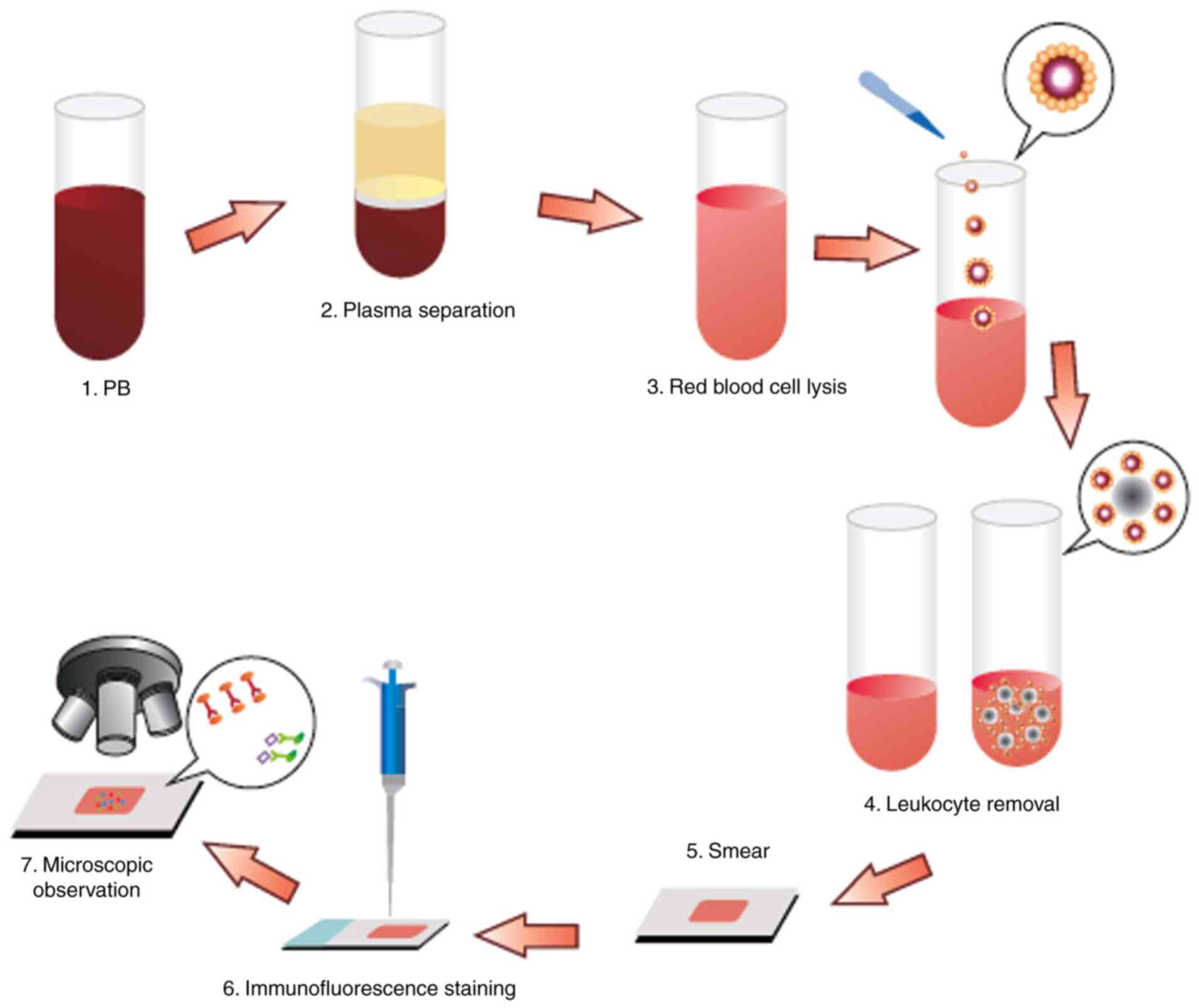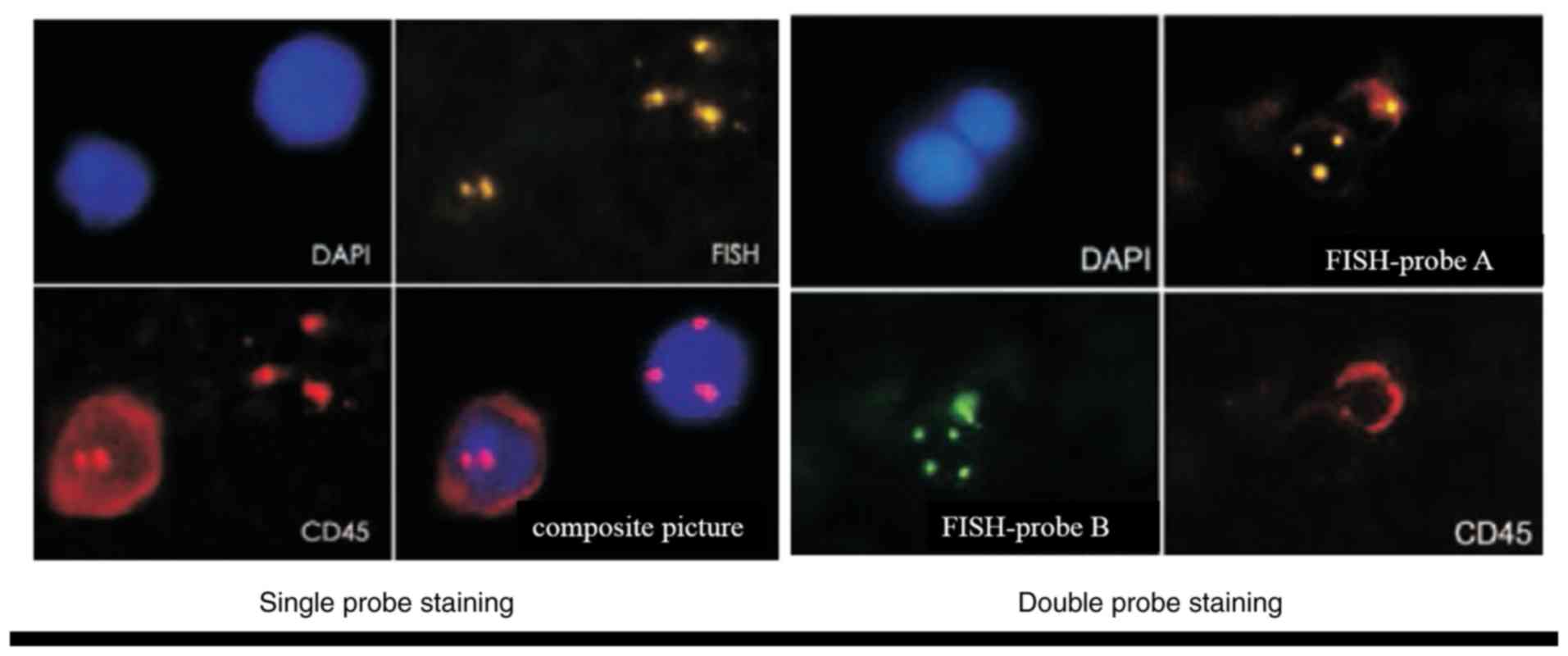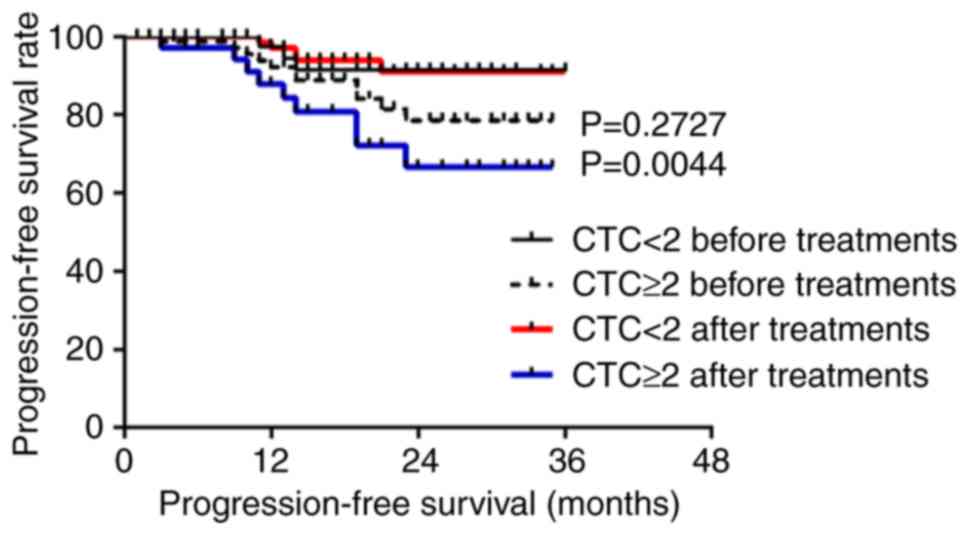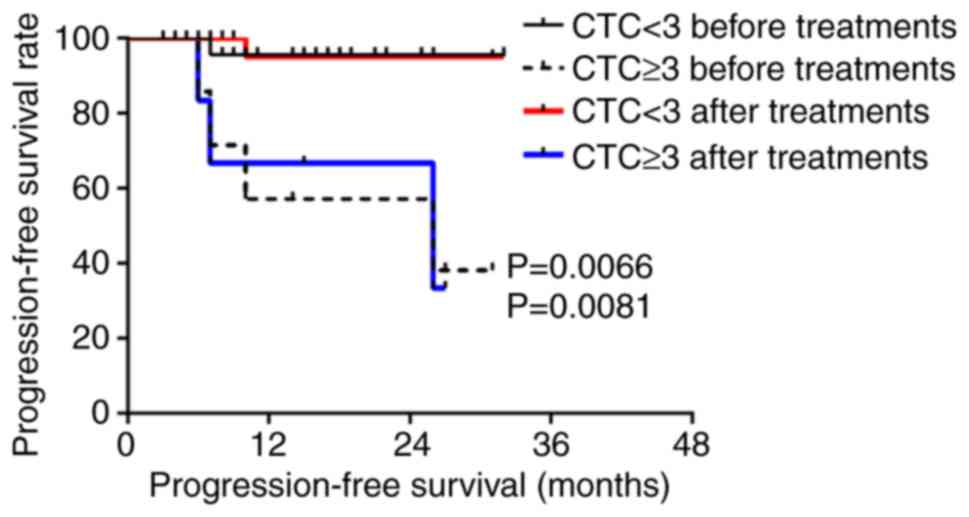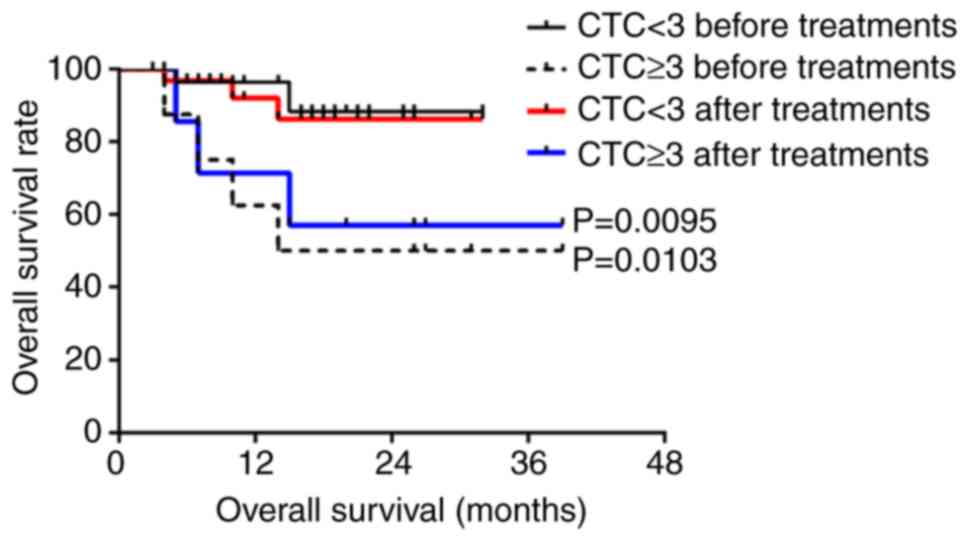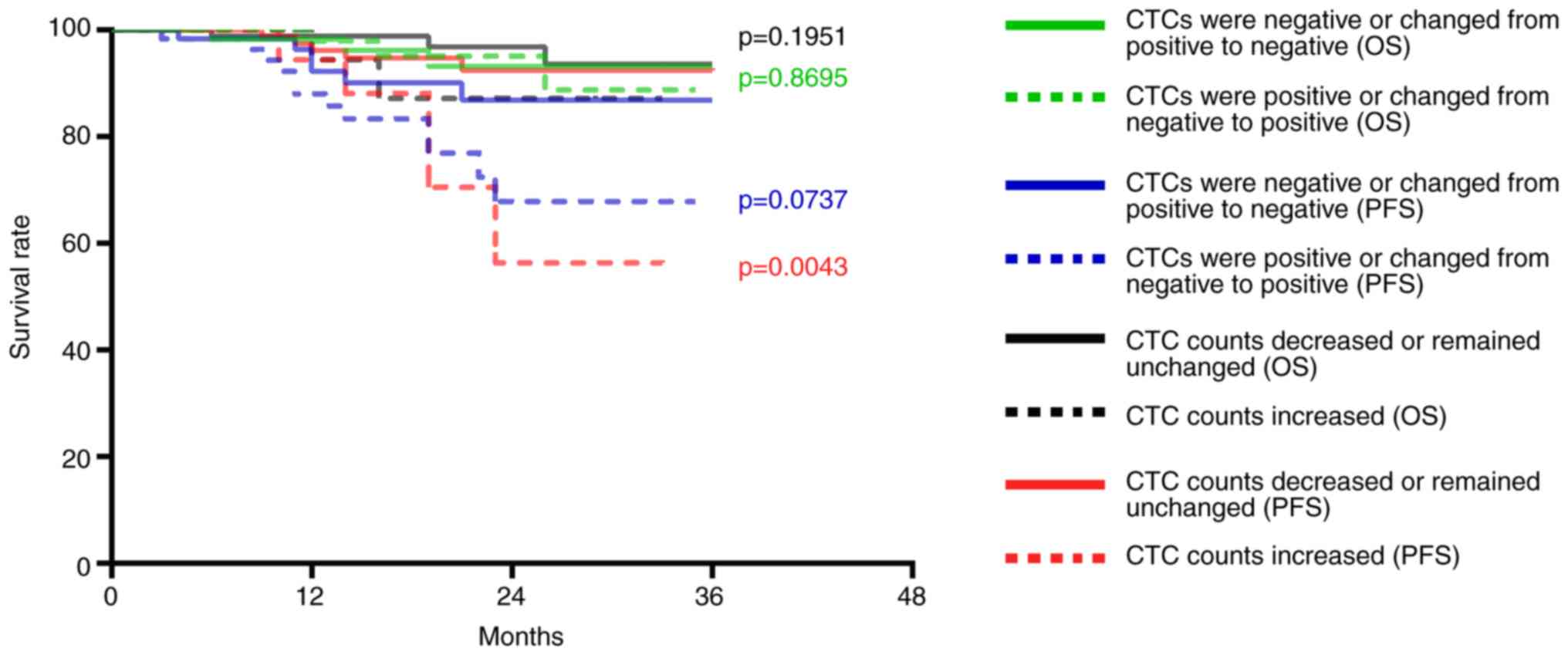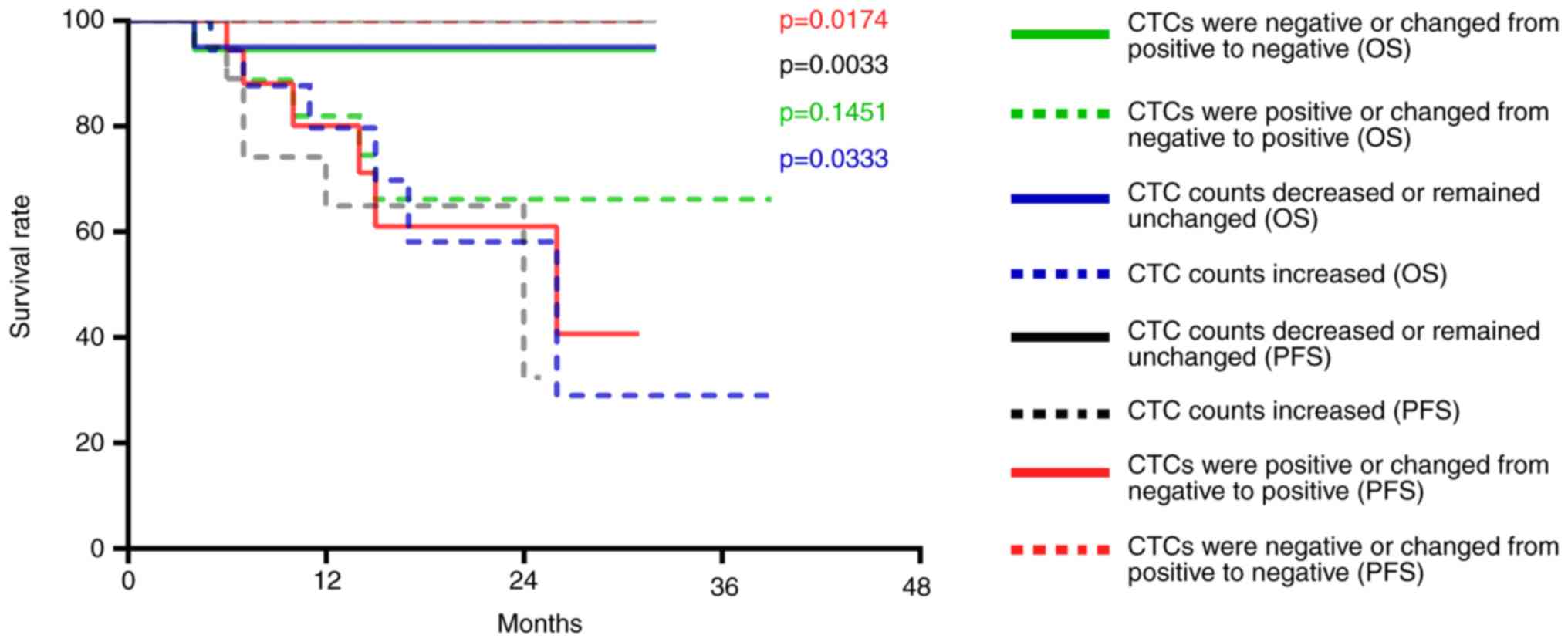|
1
|
Jatana KR, Balasubramanian P, Lang JC,
Yang L, Jatana CA, White E, Agrawal A, Ozer E, Schuller DE, Teknos
TN and Chalmers JJ: Significance of circulating tumor cells in
patients with squamous cell carcinoma of the head and neck: Initial
results. Arch Otolaryngol Head Neck Surg. 136:1274–1279. 2010.
View Article : Google Scholar : PubMed/NCBI
|
|
2
|
Fanelli MF, Oliveira TB, Braun AC, Corassa
M, Abdallah EA, Nicolau UR, da Silva Alves V, Garcia D, Calsavara
VF, Kowalski LP and Chinen LTD: Evaluation of incidence,
significance, and prognostic role of circulating tumor microemboli
and transforming growth factor-β receptor I in head and neck
cancer. Head Neck. 39:2283–2292. 2017. View Article : Google Scholar : PubMed/NCBI
|
|
3
|
Denaro N, Merlano MC and Russi EG:
Follow-up in head and neck cancer: Do more does it mean do better?
A systematic review and our proposal based on our experience. Clin
Exp Otorhinolaryngol. 9:287–297. 2016. View Article : Google Scholar : PubMed/NCBI
|
|
4
|
Economopoulou P, Kotsantis I, Kyrodimos E,
Lianidou ES and Psyrri A: Liquid biopsy: An emerging prognostic and
predictive tool in head and neck squamous cell carcinoma (HNSCC).
Focus on circulating tumor cells (CTCs). Oral Oncol. 74:83–89.
2017. View Article : Google Scholar : PubMed/NCBI
|
|
5
|
Tognela A, Spring KJ, Becker T, Caixeiro
NJ, Bray VJ, Yip PY, Chua W, Lim SH and de Souza P: Predictive and
prognostic value of circulating tumor cell detection in lung
cancer: A clinician's perspective. Crit Rev Oncol Hematol.
93:90–102. 2015. View Article : Google Scholar : PubMed/NCBI
|
|
6
|
Mateo J, Gerlinger M, Rodrigues DN and de
Bono JS: The promise of circulating tumor cell analysis in cancer
management. Genome Biol. 15:4482014. View Article : Google Scholar : PubMed/NCBI
|
|
7
|
Li F, Liu J, Song D, Zhang Q, Ding N and
He X: Circulating tumor cells in the blood of poorly differentiated
nasal squamous cell carcinoma patients: Correlation with treatment
response. Acta Otolaryngol. 136:1164–1167. 2016. View Article : Google Scholar : PubMed/NCBI
|
|
8
|
Fu X, Shen C, Wang H, Chen F, Li G and Wen
Z: Joint quantitative measurement of hTERT mRNA in both peripheral
blood and circulating tumor cells of patients with nasopharyngeal
carcinoma and its clinical significance. BMC Cancer. 17:4792017.
View Article : Google Scholar : PubMed/NCBI
|
|
9
|
Lu SH, Tsai WS, Chang YH, Chou TY, Pang
ST, Lin PH, Tsai CM and Chang YC: Identifying cancer origin using
circulating tumor cells. Cancer Biol Ther. 17:430–438. 2016.
View Article : Google Scholar : PubMed/NCBI
|
|
10
|
Zhang HD and Yu ZK: Enrichment and
detection of circulating tumor cells and its application in head
and neck squamous cell carcinoma. Zhonghua Er Bi Yan Hou Tou Jing
Wai Ke Za Zhi. 52:147–151. 2017.(In Chinese). PubMed/NCBI
|
|
11
|
Bettegowda C, Sausen M, Leary RJ, Kinde I,
Wang Y, Agrawal N, Bartlett BR, Wang H, Luber B, Alani RM, et al:
Detection of circulating tumor DNA in early- and late-stage human
malignancies. Sci Transl Med. 6:224ra242014. View Article : Google Scholar : PubMed/NCBI
|
|
12
|
Cristofanilli M, Budd GT, Ellis MJ,
Stopeck A, Matera J, Miller MC, Reuben JM, Doyle GV, Allard WJ,
Terstappen LW and Hayes DF: Circulating tumor cells, disease
progression, and survival in metastatic breast cancer. N Engl J
Med. 351:781–791. 2004. View Article : Google Scholar : PubMed/NCBI
|
|
13
|
Ramirez JM, Fehm T, Orsini M, Cayrefourcq
L, Maudelonde T, Pantel K and Alix Panabières C: Prognostic
relevance of viable circulating tumor cells detected by EPISPOT in
metastatic breast cancer patients. Clin Chem. 60:214–221. 2014.
View Article : Google Scholar : PubMed/NCBI
|
|
14
|
de Bono JS, Scher HI, Montgomery RB,
Parker C, Miller MC, Tissing H, Doyle GV, Terstappen LW, Pienta KJ
and Raghavan D: Circulating tumor cells predict survival benefit
from treatment in metastatic castration-resistant prostate cancer.
Clin Cancer Res. 14:6302–6309. 2008. View Article : Google Scholar : PubMed/NCBI
|
|
15
|
Cohen SJ, Punt CJ, Iannotti N, Saidman BH,
Sabbath KD, Gabrail NY, Picus J, Morse M, Mitchell E, Miller MC, et
al: Relationship of circulating tumor cells to tumor response,
progression-free survival, and overall survival in patients with
metastatic colorectal cancer. J Clin Oncol. 26:3213–3221. 2008.
View Article : Google Scholar : PubMed/NCBI
|
|
16
|
Reeh M, Effenberger KE, Koenig AM,
Riethdorf S, Eichstädt D, Vettorazzi E, Uzunoglu FG, Vashist YK,
Izbicki JR, Pantel K and Bockhorn M: Circulating tumor cells as a
biomarker for preoperative prognostic staging in patients with
esophageal cancer. Ann Surg. 261:1124–1130. 2015. View Article : Google Scholar : PubMed/NCBI
|
|
17
|
Racila E, Euhus D, Weiss AJ, Rao C,
McConnell J, Terstappen LW and Uhr JW: Detection and
characterization of carcinoma cells in the blood. Proc Natl Acad
Sci USA. 95:4589–4594. 1998. View Article : Google Scholar : PubMed/NCBI
|
|
18
|
Hiltermann TJN, Pore MM, Van Den Berg A,
Timens W, Boezen HM, Liesker JJ, Schouwink JH, Wijnands WJ, Kerner
GS, Kruyt FA, et al: Circulating tumor cells in small-cell lung
cancer: A predictive and prognostic factor. Ann Oncol.
23:2937–2942. 2012. View Article : Google Scholar : PubMed/NCBI
|
|
19
|
Krebs MG, Sloane R, Priest L, Lancashire
L, Hou JM, Greystoke A, Ward TH, Ferraldeschi R, Hughes A, Clack G,
et al: Evaluation and prognostic significance of cir-culating tumor
cells in patients with non-small-cell lung cancer. J Clin Oncol.
29:1556–1563. 2011. View Article : Google Scholar : PubMed/NCBI
|
|
20
|
Matsusaka S, Chin K, Oqura M, Suenaga M,
Shinozaki E, Mishima Y, Terui Y, Mizunuma N and Hatake K:
Circulating tumor cells as a surrogate marker for determining
response to chemotherapy in patients with advanced gastric cancer.
Cancer Sci. 101:1067–1071. 2010. View Article : Google Scholar : PubMed/NCBI
|
|
21
|
Rao C, Bui T, Connelly M, Doyle G, Karydis
I, Middleton MR, Clack G, Malone M, Coumans FA and Terstappen LW:
Circulating melanoma cells and survival in metastatic melanoma. Int
J Oncol. 38:755–760. 2011.PubMed/NCBI
|
|
22
|
Gazzaniga P, Gradilone A, de Berardinis E,
Busetto GM, Raimondi C, Gandini O, Nicolazzo C, Petracca A,
Vincenzi B, Farcomeni A, et al: Prognostic value of circulating
tumor cells in nonmuscle invasive bladder cancer: A cellsearch
analysis. Ann Oncol. 23:2352–2356. 2012. View Article : Google Scholar : PubMed/NCBI
|
|
23
|
Poveda A, Kaye SB, McCormack R, Wang S,
Parekh T, Ricci D, Lebedinsky CA, Tercero JC, Zintl P and Monk BJ:
Circulating tumor cells predict progression free survival and
overall survival in patients with relapsed/recurrent advanced
ovarian cancer. Gynecol Oncol. 122:567–572. 2011. View Article : Google Scholar : PubMed/NCBI
|
|
24
|
Harris L, Firtsche H, Mennel R, Norton L,
Ravdin P, Taube S, Somerfield MR, Hayes DF and Bast RC Jr; American
Society of Clinical Oncology, : American Society of Clinical
Oncology 2007 update of recommendations for the use of tumor
markers in breast cancer. J Clin Oncol. 25:5287–5312. 2007.
View Article : Google Scholar : PubMed/NCBI
|
|
25
|
Edge SB and Compton CC: The American joint
committee on cancer: The 7th edition of the AJCC cancer staging
manual and the future of TNM. Ann Surg Oncol. 17:1471–1474. 2010.
View Article : Google Scholar : PubMed/NCBI
|
|
26
|
Zhang L, Riethdorf S, Wu G, Wang T, Yang
K, Peng G, Liu J and Pantel K: Meta-analysis of the prognostic
value of circulating tumor cells in breast cancer. Clin Cancer Res.
18:5701–5710. 2012. View Article : Google Scholar : PubMed/NCBI
|
|
27
|
Buglione M, Grisanti S, Almici C, Mangoni
M, Polli C, Consoli F, Verardi R, Costa L, Paiar F, Pasinetti N, et
al: Circulating tumour cells in locally advanced head and neck
cancer: Preliminary report about their possible role in predicting
response to non-surgical treatment and survival. Eur J Cancer.
48:3019–3026. 2012. View Article : Google Scholar : PubMed/NCBI
|
|
28
|
Nichols AC, Lowes LE, Szeto CCT, Basmaji
J, Dhaliwal S, Chapeskie C, Todorovic B, Read N, Venkatesan V,
Hammond A, et al: Detection of circulating tumor cells in advanced
head and neck cancer using the CellSearch system. Head Neck.
34:1440–1444. 2012. View Article : Google Scholar : PubMed/NCBI
|
|
29
|
Hristozova T, Konschak R, Budach V and
Tinhofer I: A simple multicolor flow cytometry protocol for
detection and molecular characterization of circulating tumor cells
in epithelial cancers. Cytometry A. 81:489–495. 2012. View Article : Google Scholar : PubMed/NCBI
|
|
30
|
Tinhofer I, Hristozova T, Stromberger C,
Keilhoiz U and Budach V: Monitoring of circulating tumor cells and
their expression of EGFR/phospho-EGFR during combined radiotherapy
regimens in locally advanced squamous cell carcinoma of the head
and neck. Int J Radiat Oncol Biol Phys. 83:e685–e690. 2012.
View Article : Google Scholar : PubMed/NCBI
|
|
31
|
Bozec A, Ilie M, Dassonville O, Long E,
Poissonnet G, Santini J, Chamorey E, Ettaiche M, Chauvière D,
Peyrade F, et al: Significance of circulating tumor cell detection
using the cellsearch system in patients with locally advanced head
and neck squamous cell carcinoma. Eur Arch Otorhinolaryngol.
270:2745–2749. 2013. View Article : Google Scholar : PubMed/NCBI
|
|
32
|
Wollenberga B, Walza A, Kolbow K, Pauli C,
Chaubal S and Andratschke M: Clinical relevance of circulating
tumour cells in the bone marrow of patients with SCCHN. Onkologie.
27:358–362. 2004.PubMed/NCBI
|
|
33
|
Oken MM, Creech RH, Tormey DC, Horton J,
Davis TE, McFadden ET and Carbone PP: Toxicity and response
criteria of the Eastern cooperative oncology group. Am J Clin
Oncol. 5:649–655. 1982. View Article : Google Scholar : PubMed/NCBI
|
|
34
|
Zhang Z, Xiao Y, Zhao J, Chen M, Xu Y,
Zhong W, Xing J and Wang M: Relationship between circulating tumour
cell count and prognosis following chemotherapy in patients with
advanced non-small-cell lung cancer. Respirology. 21:519–525. 2016.
View Article : Google Scholar : PubMed/NCBI
|
|
35
|
Tanaka M, Takeuchi H, Osaki Y, Hiraiwa K,
Nakamura R, Oyama T, Takahashi T, Wada N, Kawakubo H, Saikawa Y, et
al: Prognostic significance of circulating tumor cells in patients
with advanced esophageal cancer. Esophagus. 12:352–359. 2015.
View Article : Google Scholar
|
|
36
|
Cao Q, Gao X, Lin Y, Yue C, Wang Y, Quan
F, Zhang Z, Liu X, Lu Y, Zhan Y, et al: Thymopentin ameliorates
dextran sulfate sodium-induced colitis by triggering the production
of IL-22 in both innate and adaptive lymphocytes. Theranostics.
9:7490–7505. 2019. View Article : Google Scholar : PubMed/NCBI
|
|
37
|
Wu X, Li X, Fu Q, Cao Q, Chen X, Wang M,
Yu J, Long J, Yao J, Liu H, et al: AKR1B1 promotes basal-like
breast cancer progression by a positive feedback loop that
activates the EMT program. J Exp Med. 214:1065–1079. 2017.
View Article : Google Scholar : PubMed/NCBI
|
|
38
|
Zhang C, Wang L, Guan Y, Sun Y, Liu X, Zhu
D and Guo Q: Progress of circulating tumor cells in cancer
management. Technol Cancer Res Treat. 15:509–516. 2016. View Article : Google Scholar : PubMed/NCBI
|
|
39
|
Zhang X, Wei L, Li J, Zheng J, Zhang S and
Zhou J: Epithelial-mesenchymal transition phenotype of circulating
tumor cells is associated with distant metastasis in patients with
NSCLC. Mol Med Rep. 19:601–608. 2019.PubMed/NCBI
|
|
40
|
Castro J, Sanchez L, Nuñez MT, Lu M,
Castro T, Sharifi HR and Ericsson C: Screening circulating tumor
cells as a noninvasive cancer test in 3388 individuals from
high-risk groups (ICELLATE2). Dis Markers. 2018:46531092018.
View Article : Google Scholar : PubMed/NCBI
|
|
41
|
Bidard FC, Peeters DJ, Fehm T, Nolé F,
Gisbert-Criado R, Mavroudis D, Grisanti S, Generali D, Garcia-Saenz
JA, Stebbing J, et al: Clinical validity of circulating tumour
cells in patients with metastatic breast cancer: A pooled analysis
of individual patient data. Lancet Oncol. 15:406–414. 2014.
View Article : Google Scholar : PubMed/NCBI
|
|
42
|
Li L, Liu Y, Zhang S, Wang T, Bian L, Wu
S, Song S, Liu B and Jiang Z: Detection of circulating tumor cells
and its clinical value for different stages and various subtypes of
breast cancer. Zhonghua Yi Xue Za Zhi. 94:2812–2815. 2014.(In
Chinese). PubMed/NCBI
|
|
43
|
Bu XM, Xu FF, Ma J and Jiang B: The
expression of circulating tumor cells in peripheral blood of
patients with non-small cell lungcancer and its detection. J Biol
Regul Homeost Agents. 32:843–849. 2018.PubMed/NCBI
|
|
44
|
Gorges TM, Tinhofer I, Drosch M, Röse L,
Zollner TM, Krahn T and von Ahsen O: Circulating tumour cells
escape from EpCAM-based detection due to epithelial-to-mesenchymal
transition. BMC Cancer. 12:1782012. View Article : Google Scholar : PubMed/NCBI
|
|
45
|
Yin SL, Liu FK, Cai DM, et al: Effect of
perioperative administration of thymopentin on cellular immunity
and cytokine level following cardiopulmonary bypass. Xinfei
Xueguanbing Zazhi. 30:116–118, 121. 2011.(In Chinese).
|
|
46
|
Tinhofer I and Staudte S: Circulating
tumor cells as biomarkers in head and neck cancer: Recent advances
and future outlook. Expert Rev Mol Diagn. 18:897–906. 2018.
View Article : Google Scholar : PubMed/NCBI
|
|
47
|
McMullen KP, Chalmers JJ, Lang JC, Kumar P
and Jatana KR: Circulating tumor cells in head and neck cancer: A
review. World J Otorhinolaryngol Head Neck Surg. 2:109–116. 2016.
View Article : Google Scholar : PubMed/NCBI
|















